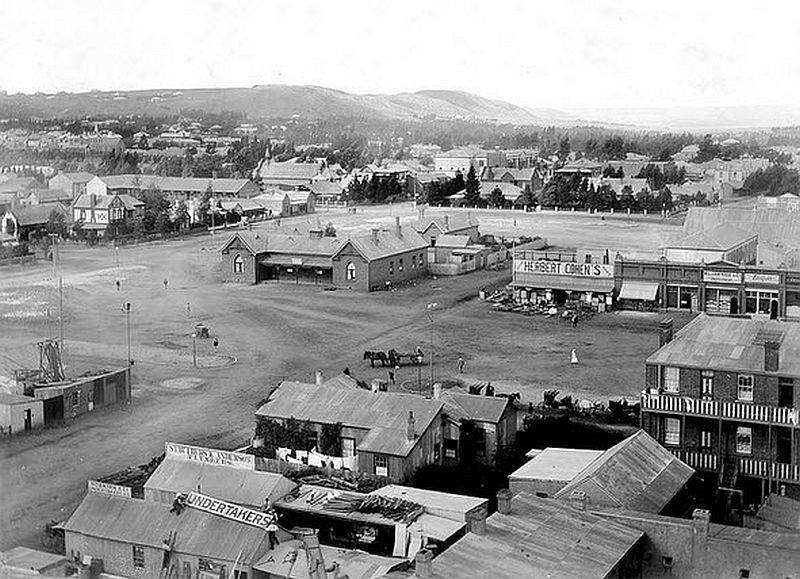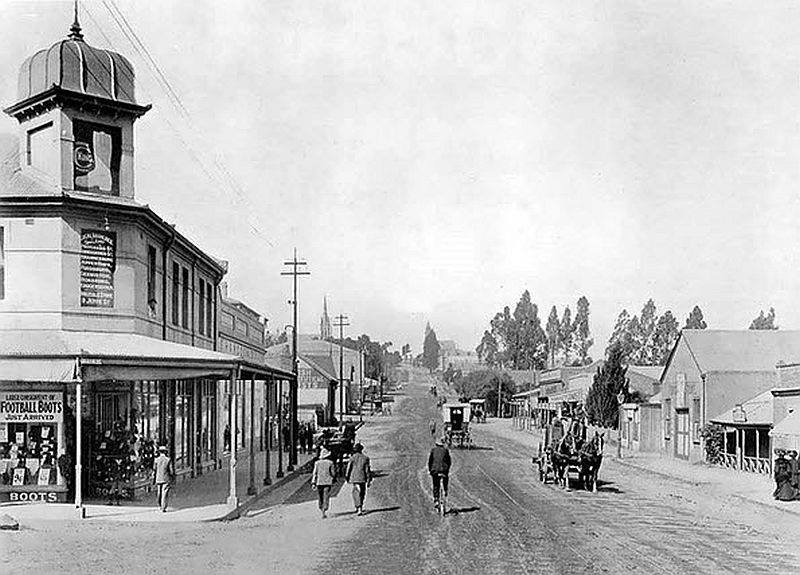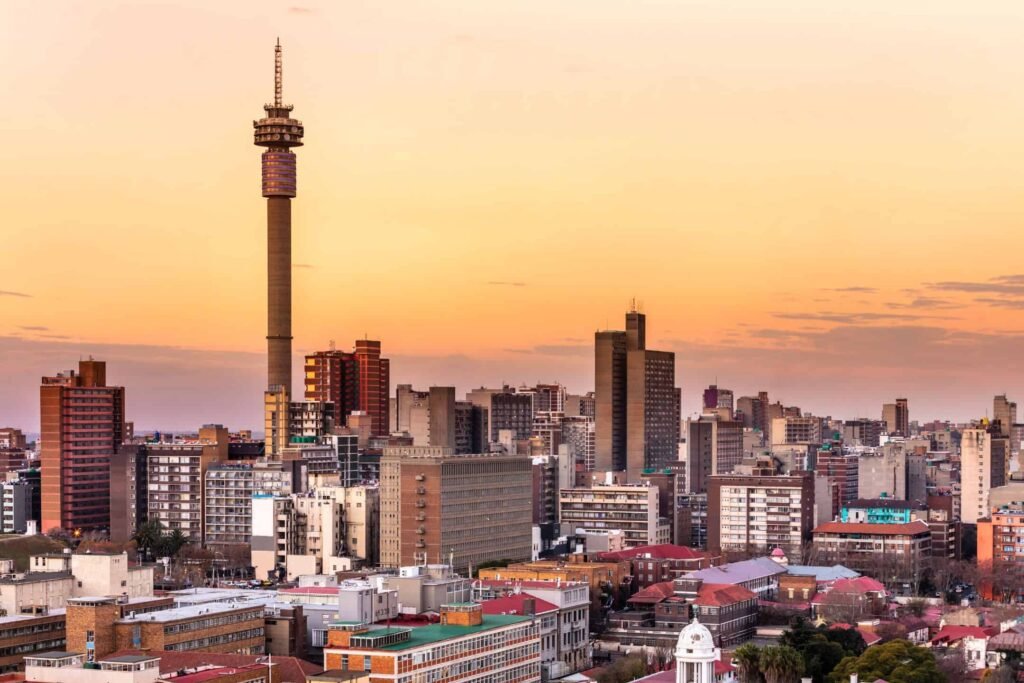Johannesburg Then and Now
Johannesburg Then
Johannesburg, the largest city in South Africa, was established in 1886 following the discovery of gold in the area.
The city’s name has sparked some controversy, as the precise origin remains unclear.
There were several key figures in the city’s early history with the name “Johannes,” which may have influenced the choice.
Notably, Hendrik Dercksen, the principal clerk to the surveyor-general, and Christiaan Johannes Joubert, a prominent figure in the South African Republic’s mining industry, are among the possibilities.
Additionally, Paul Kruger, the president of the South African Republic, and Johannes Meyer, the first government official in the region, are also considered potential sources for the name.

The loss of detailed records means the exact reasoning behind the city’s name remains uncertain, though it is likely connected to the roles of these individuals in the development of the area.
Landmarks such as Rissik Street and the Rissik Street Post Office, named after Johannes Rissik, a key figure in obtaining mining rights, further contribute to the city’s historical association with these early figures.
Related Article: Cairo Then and Now
Johannesburg History
Johannesburg’s early history is inextricably linked to the discovery of gold, which transformed the region into one of the world’s major cities.
The first hints of gold in the area came in 1853 when prospector Pieter Jacob Marais discovered alluvial gold in the Jukskei River.
Though a few subsequent strikes were made, it wasn’t until 1886 that the rich gold deposits of the Witwatersrand Main Reef were uncovered by Australian prospector George Harrison.
Ironically, Harrison didn’t recognize the value of his discovery and sold his claim for a mere £10.
Related Article: Denver Then and Now
As word spread, thousands of miners, known as “diggers,” flocked to the region, sparking a gold rush.
The influx of fortune seekers and workers from around the world laid the foundations for Johannesburg’s rapid development.
To manage the growing population and burgeoning gold industry, the Transvaal government sent two officials, Christiaan Johannes Joubert and Johann Rissik, to survey the area and establish a city.
By mid-1886, Johannesburg was officially founded, and it quickly became the world’s last great boomtown of the 19th century.
Related Article: Seattle Then and Now
People came from all corners of the globe—miners from Cornwall, Australia, and California, and laborers from across Southern Africa.
With the city’s rapid growth came extreme inequality, with destitute Afrikaners and migrant workers, particularly Black Africans, enduring harsh living conditions in overcrowded slums.
By 1896, the population reached 100,000, and Johannesburg was thriving despite its rough, often lawless reputation, becoming a magnet for vice, criminal syndicates, and a booming, yet dangerous, economy.
The city’s gold industry, while immensely profitable, was plagued by technical challenges.
Related Article: Dallas Then and Now
The gold deposits were low-grade and required extensive processing to yield even small amounts of gold, and as the reefs dipped deeper underground, the cost of mining rose.
This prompted consolidation of the industry by the mid-1890s, with a handful of powerful mining magnates, known as “Randlords,” taking control of the goldfields.
These figures, such as Alfred Beit and Barney Barnato, brought industrial expertise to South Africa from their experience in the diamond industry.
They quickly sought to reduce operational costs, particularly the cost of labor, by pushing for discriminatory labor laws and policies.
Related Article: Miami Then and Now

The Randlords grew increasingly frustrated with the Transvaal government’s inefficiency and corruption, believing it lacked the understanding to meet the needs of a modern, industrialized economy.
Their frustration was compounded by British imperial interests, which sought to bring the gold-rich Transvaal under British control.
This tension ultimately led to the Jameson Raid of 1895, an unsuccessful attempt to overthrow the Transvaal government.
Related Article: Washington D.C. Then and Now
The situation escalated further with the British government’s demand for the enfranchisement of “uitlanders”—foreign, mostly British miners in Johannesburg, who were denied voting rights under Transvaal law.
This led to the outbreak of the South African War (1899–1902), also known as the Boer War.
After the British victory, Johannesburg and the surrounding region were incorporated into the British Empire, and the gold mines resumed operations.
Related Article: Boston Then and Now
The British government quickly catered to the needs of the mining industry by eliminating tariffs and creating labor laws that reduced wages for Black workers.
This included the controversial importation of Chinese indentured laborers when local Black workers were reluctant to accept low wages.
By the time South Africa became a unified nation in 1910, Johannesburg’s gold industry was on solid footing, having played a significant role in shaping the economic and social landscape of the region.
Related Article: San Francisco Then and Now
Johannesburg Now

Johannesburg is the largest city in South Africa, with a population of over 4.8 million people as of the latest figures, making it one of the largest urban areas in the world.
It is the economic hub of the country and the provincial capital of Gauteng, the wealthiest province in South Africa.
Johannesburg’s status as a megacity reflects its importance as both an economic powerhouse and a significant global city, ranking among the top 100 urban areas globally.
Related Article: Panama City Then and Now
It serves as the center for major industries, including banking, mining, and business, housing the headquarters of many of South Africa’s largest companies.
Additionally, Johannesburg is the seat of South Africa’s Constitutional Court, the highest judicial body in the country, highlighting its political and legal significance.
The city’s location within the mineral-rich Witwatersrand hills has been a key factor in its development.
Related Article: Quito Then and Now
The region is globally recognized for its vast gold and diamond deposits, which have long attracted international interest and investment.
The discovery of gold in the area in the late 19th century sparked the rapid growth of Johannesburg, transforming it from a small mining camp into a bustling metropolis.
Today, Johannesburg continues to be a major player in the global mineral trade, with the mining industry still an important part of its economy.
Related Article: Santiago Then and Now
Johannesburg also gained global recognition as one of the host cities for the 2010 FIFA World Cup, underscoring its international importance and the city’s modern infrastructure.
As a “global city” or “alpha city,” Johannesburg is integral to the global network of cities that drive economic, political, and cultural trends.
By 2019, the population of the metropolitan area had grown to over 8 million, cementing its status as the most populous city in South Africa.
Related Article: Santiago Then and Now
The city is situated on the Highveld, an elevated plateau at 1,753 meters above sea level, giving it a unique geographical and climatic profile.
Johannesburg’s Central Business District (CBD) is located on the southern edge of the Witwatersrand ridge, which runs across the city from west to east.
The city’s terrain is characterized by undulating hills to the north and west, while the eastern parts are more flat.
Related Article: Bogota Then and Now
The Witwatersrand ridge also acts as a watershed, with the northern parts of Johannesburg draining into the Jukskei River, while the southern areas drain into the Klip River.
This topographical variation adds to the city’s diverse landscapes, which range from bustling urban centers to quieter residential neighborhoods and industrial zones.
Related Article: Lima Then and Now
FAQs
Johannesburg is famous for being South Africa’s economic hub, its rich history tied to the gold mining industry, and its role as a global city.
It’s also known for its cultural diversity, landmarks, and being a major business center in Africa.
Johannesburg offers many opportunities, modern amenities, and a vibrant cultural scene, but it also faces challenges like high crime rates and social inequality.
Whether it’s a good place to live depends on personal preferences and priorities.
Johannesburg is called the “City of Gold” due to the discovery of gold in the Witwatersrand in 1886, which led to the city’s rapid growth as a mining and financial center.
No, Johannesburg is not the capital of South Africa. The capital is Pretoria, where the government is based, while Johannesburg is the country’s largest city and an economic powerhouse.






























